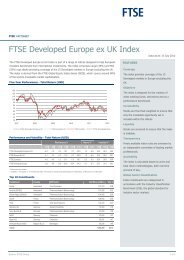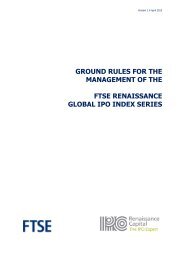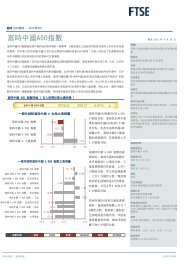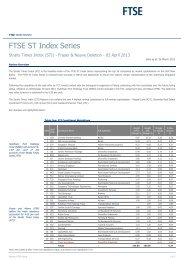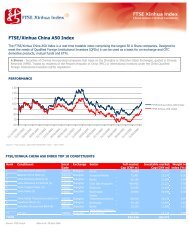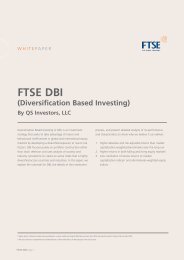Create successful ePaper yourself
Turn your PDF publications into a flip-book with our unique Google optimized e-Paper software.
Covered bonds have underlined their importance and stabilising role in mortgage financing in<br />
Europe to such an extent that the authorities in the United States are seeking to introduce a set of<br />
guidelines designed to replicate the high quality of this quintessentially European instrument. In<br />
part because of the safe-haven reputation of covered bonds it appeared for most of 2007 and early<br />
2008 to have successfully withstood the credit crisis. However, partly because the availability of<br />
executable prices for bonds on screens highlighted their vulnerability, and partly because the fixed<br />
bid/ask spreads in covered bonds started to become far smaller than the bid/ask spreads in any<br />
comparable markets (most significantly perhaps in the swaps and agency markets) the contagion<br />
that affected other credit markets began to impinge on Europe’s covered bonds. Questions are still<br />
extant as to the true nature of covered bonds: either as a ratings or a credit product. Whatever the<br />
ultimate outcome of that debate, we asked some of the leading market makers in the covered<br />
bond market to give us their views on the sustainability and future of this deep and diversified<br />
market through 2009 and beyond.<br />
After what looked to be a protracted period of<br />
stability, the European covered bond market hit a high<br />
wall in the late summer/early autumn, as it began to<br />
feel the impact of the contagion that has created<br />
extreme volatility in the global capital markets. What<br />
do you think were the main reasons for the relative<br />
lateness of this dip and the intensity of the dip when<br />
it did arrive?<br />
DR. LOUIS HAGEN, ASSOCIATION OF GERMAN<br />
PFANDBRIEF BANKS: Until mid-September at least the<br />
Pfandbrief market proved exceptionally resilient to<br />
dislocations in the capital markets in general and their<br />
impact on the covered bond market in particular. This is<br />
due to the solid legal foundations provided by the<br />
Pfandbrief Act and the flawless track record of the<br />
Pfandbrief market and its committed domestic investor<br />
base. The different formats of Pfandbrief, i.e. bearer<br />
instruments in traditional or Jumbo size and registered<br />
Pfandbrief offer a wide spectrum to investors. Especially<br />
tailor made issues and private placements were sought for<br />
and the German investor community proved to be solid as<br />
a rock. The suddenness of the disruption in demand clearly<br />
had some irrational motives when Pfandbrief was taken<br />
hostage by negative headlines that originated in the US<br />
and in Ireland. Pfandbrief markets were shocked by two<br />
events. First the Lehman insolvency and subsequently the<br />
Hypo Real Estate rescue action. The bail-out of<br />
HypoRealEstate closed the market where you may have<br />
expected it to underpin the commitment of the entire<br />
German financial community to protect the Pfandbrief<br />
from harm. In the aftermath of the European rescue<br />
packages and the creation of a new asset class – state<br />
guaranteed senior unsecured bank bonds – the market<br />
now is going through a period of re-pricing in order to find<br />
levels commensurate with the new credit environment and<br />
new competitors. But I would like to make clear that<br />
Pfandbrief issuance is still working. Issuance levels,<br />
however, have halved during the last two months.<br />
TED LORD, BARCLAYS CAPITAL: Throughout the credit<br />
crisis and liquidity problems facing many sectors of the<br />
F T S E G L O B A L M A R K E T S • J A N U A R Y / F E B R U A R Y 2 0 0 9<br />
capital markets, investors have maintained their faith in the<br />
covered bond asset class. Investors still purchase covered<br />
bonds in private placement format and in the secondary<br />
market. Due to the liquidity problems in the secondary<br />
market, however, some investors are seeing covered bonds<br />
more as a credit product and not as much as a<br />
rates/government bond surrogate product.”<br />
CARLOS STILIANOPOULOS, CAJA MADRID: Since the<br />
beginning of the crisis back in August 2007 investors´<br />
appetite has been draining away gradually from the<br />
different products in accordance with their risk perception<br />
on the products. This is probably why investors have been<br />
buying Covered Bonds all the way up to summer 2008,<br />
whilst at the same time they had stopped buying other<br />
products which they considered riskier, starting on<br />
securitized transactions, tier II and tier I deals, and finally<br />
senior unsecured. However, further turmoil in the markets<br />
during the months of September and October has even<br />
affected safer products such as Covered Bonds.<br />
Do you think there were infrastructural weaknesses<br />
or vulnerabilities in the make up of the trading<br />
market, which were exacerbated by the global crisis,<br />
such as: the availability of continuous executable<br />
prices on bond screens?/ or the extreme narrowing of<br />
bid/ask covered bond spreads?<br />
TIM SKEET, MERRILL LYNCH: The recent re-pricing of the<br />
SSA curve, though itself not helpful in the overall picture of<br />
the capital markets evolution has at least served to bring a<br />
measure of consistency to the performance of all the asset<br />
classes. Covered bonds have suffered but without<br />
exception so has every part of the market<br />
Despite the current turmoil, there is a belief that<br />
the European covered bond model is far superior to<br />
that in the United States. Is this wishful thinking,<br />
or is there real substance behind the claim.<br />
Moreover, if it is true, in a post crisis market is it<br />
feasible for Europeans to export their expertise to<br />
the US and Asia?<br />
75



